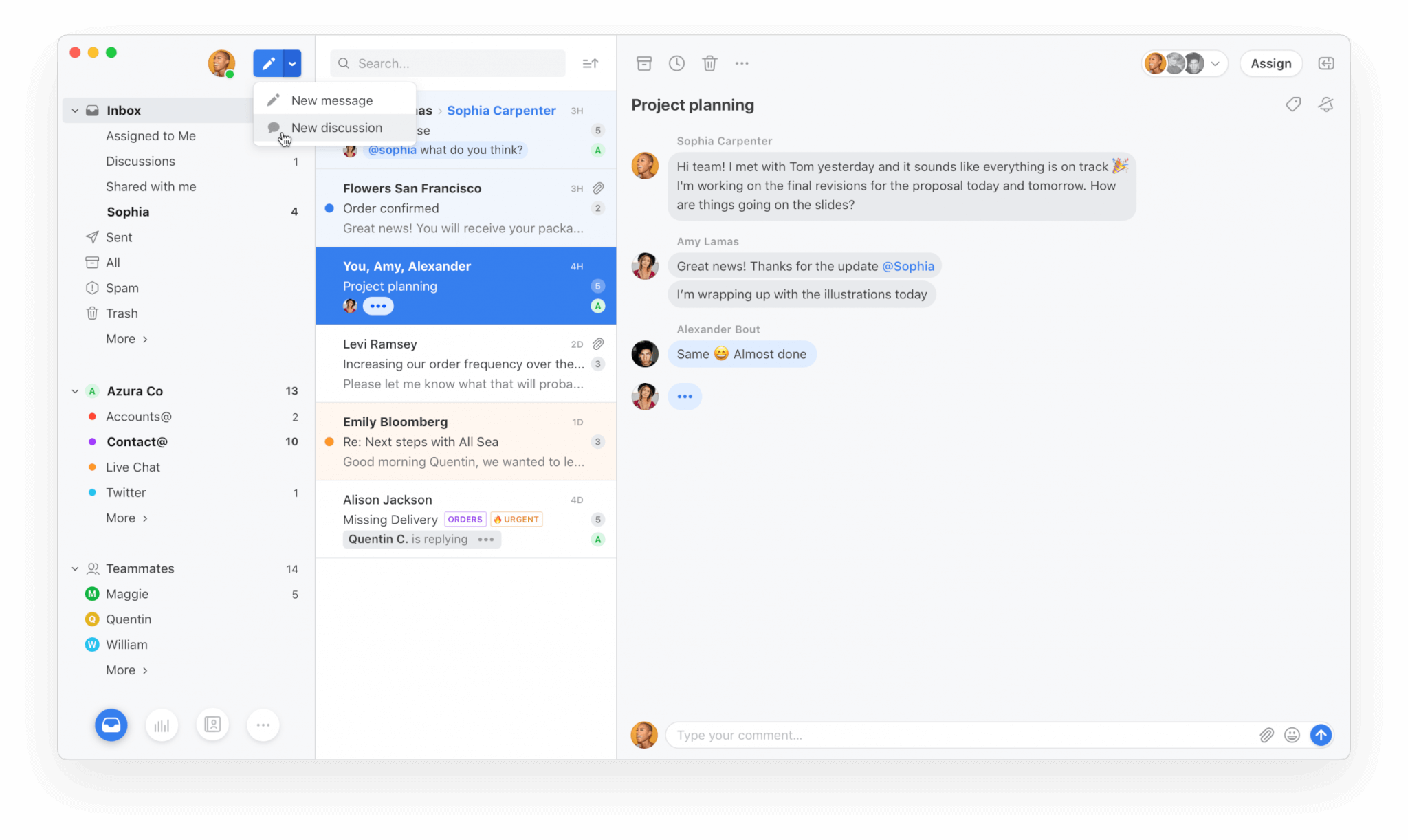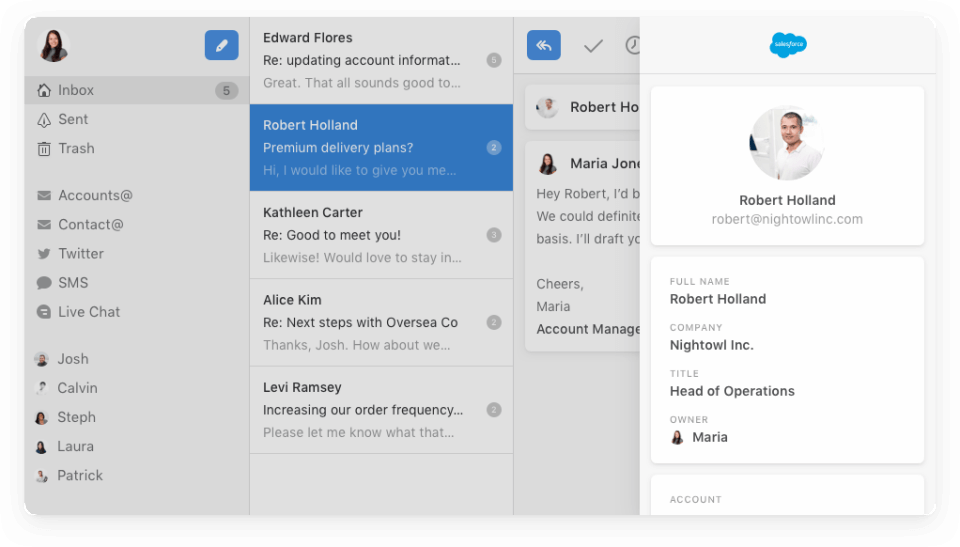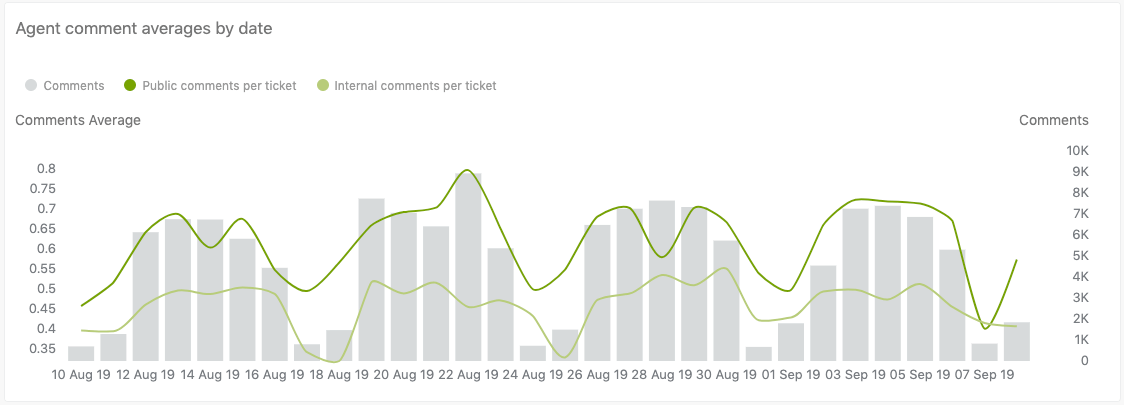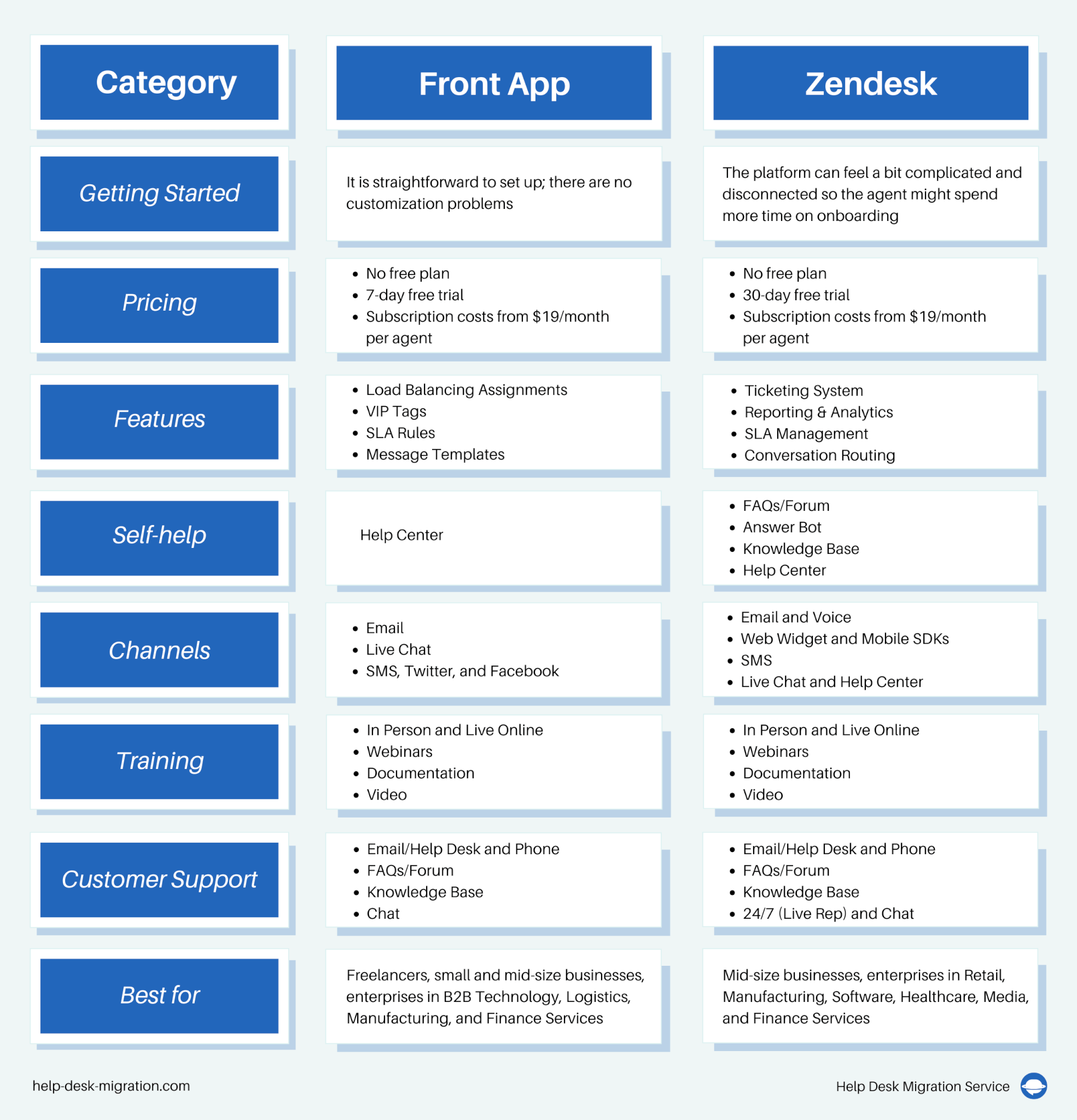The industry never sleeps. Each day, we get new help desk solutions, new features, and new interfaces. Yet, are all these new contenders good? Or are they all not worth your time and investments? Well, to find out, we decided to stack Front app vs Zendesk to see if that's the case. After all, Zendesk has been in the industry for years and is considered one of, if not the best, tools out there. So, let’s take a look at Front App. Who knows, it might be a solid alternative to Zendesk.
Front App Overview
We’ll start our Front app vs Zendesk overview by looking at the newcomer. We will touch upon the features, the UI/UX, and, of course, the pricing. We feel that these specifics are the most important and most commonly asked. But before we jump into details, we’d like to state that Front App is a help desk-like system that provides your team with many communication options. It encompasses all your emails, chats, SMS, and social media messages into one convenient inbox. The tool also has a bunch of automation options and an analytics module. It can be connected to a wide range of third-party solutions for better performance, now on to the next section.
Features
So, if we had to outline the three core features of Front App, that would be the aforementioned shared inbox, the Internal visibility system, and the multichannel communication module. All these tools allow your employees to work faster and better, especially under load, but let’s take a look at each separately.
Shared Inbox. As we already said, the shared inbox allows you to gather data across all your channels. Whether it is an SMS system, a Live Chat solution, or social media platforms, you will be able to gather all your requests, questions, and suggestions in one convenient box. This inbox will label and tag all your incoming messages based on the source, and it even understands context, so you don’t have to worry that support requests will go unnoticed.

Apart from seeing all the available customer issues, you have the ability to create internal conversations. Thus, you can communicate with colleagues much faster. Source: Front App
Internal Visibility System. This system allows your team to work faster and better by providing more visibility inside the working space. It enables you to unify customer information into one place, meaning your team will not have to scavenge all the bits of data from all over the place. Also, as part of this tool is the ability to extend the reach of this system through the API. You don’t have to limit yourself to just your inbox when you can integrate your CRM, external inboxes, and backends. This system is superb for small and large companies as it has all the means to scale correctly and effectively.

You can view and add all the important details on customers in their profiles. Source: Capterra
Multichannel Communication. The last feature we’d like to discuss is multichannel communication. It does what it says: It provides the ability to communicate effortlessly across a number of platforms. It doesn’t have super fancy options, but it is blazingly fast. We’ve seen many features like this, but this one might be the top performer. There are no delays or hiccups; it is like chatting on the native platform.

You can add a variety of communication channels to your Front app account and then automatically receive them all in a single inbox.
User Interface
Now that we know the features, it is time to take a look at the UI. If you used any third-party email apps, you’ll feel right at home. On the left side, you have all your inboxes and messages, whereas the main body is cluttered with messages themselves. The top right corner is populated with your profile icon and notification bells, as well as the online status of other users.

See any info you need in a single interface in Front. Source: TrustRadius
Overall, it is very clean as it doesn’t have a background image (you can add one if you like), and all icons are visible and distinct. The speed of each tab and menu is fast unless you open a gazillion of emails at once then it will most likely plummet. But generally speaking, it is good stuff, and we had zero issues using it.
Price
Now, for the juicy part, here are the pricing options. Front App comes in four different plans called Starter (9$ user/month), Plus ($24 user/month), Pro ($39 user/month), and Enterprise ($79 user/month), respectively. Remember that the prices listed are for the annual subscription; paying every month will be much more expensive. Paying for the Pro plan will get you access to all of the features mentioned above, as well as Unlimited advanced rules, Load balancing rules for faster responses, CRM integrations, Data exports, and In-app billing management.
Zendesk Overview
Zendesk needs no introduction, but we’ll do it anyway. Zendesk is a powerful help desk tool with all the basic features and some exclusive ones. Over the years, it has gained a cult following among companies and is widely recognized as the best tool for all your automation and multi-brand support needs.
Features
There’s a reason we have so many Zendesk alternatives these days. The tool is very popular and highly polished. Among the best things about Zendesk are its features, namely Customization and personalization, Native Integrations, and Performance Dashboard. So, let’s take a look at each.
Customization & Personalization. Zendesk was built with customization in mind right from the get-go. The tool supports not only color changes but themes, different layouts, and even stylization. And this customization comes with modularity, too. You can do that if you want your knowledge base to look different from your main page. And if you want to use a third-party theme, you can do that as well.

One of the custom themes for Zendesk Knowledge Base from the GrowthDot service. Source: GrowthDot
Native Integration. Another cool feature of Zendesk is its ability to integrate with other Zendesk products seamlessly. Whether you need a more advanced chat or a dedicated call center system, you can do that by pressing a few buttons. There is no need to mess with the API or coding; simply use your help desk credentials with other services, and you are good to go.

You can integrate different Zendesk products and easily access them in your interface.
Performance Dashboards. Finally, there are dashboards. These are amazing as they allow you to track just about anything. Whether it is performance, income, or customer satisfaction, you can view all this information using the dashboard tool. This provides an extra layer of visibility and will allow you to track issues more carefully.

Zendesk reporting tool enables the creation of several different reports. For example, this one shows the overall number of comments and public and internal comments for a certain date. Source: Zendesk
User Interface
Now, if there’s one thing that is undoubtedly good, it is Zendesks UI. It is simple and easy to navigate and, as already stated, highly customizable. Yet, even if you judge it as is, it is sleek and fast. We had zero issues finding functions and managing tickets. On the left side, you have a sidebar with all the options you might need; on top of that, you have the context-aware search tool. The main body is filled with communication windows, whereas the right side prominently features all the customer information.

Like Front, in Zendesk, you can view all the necessary information from one interface. Source: Zendesk
Professional Services
For existing customers, Zendesk offers Professional Services to provide them with a complete omnichannel experience. That includes assistance with such processes as
- onboarding;
- strategic implementation;
- solution customization, including fine-tuning features and integrations;
- data migration
You can choose from four Suite Transition Services packages. The pricing starts at $8K for setting up one channel and is only for Zendesk Suite. So, if you need to import your customer data to Zendesk Support, this option isn’t available.
In this case, consider Help Desk Migration. The migration price depends on the number of migrated records and starts at $39. Whether you want to merge Zendesk instances or export data from another help desk solution, the automated migration service can do both.
Price
Lastly, we have pricing. The tool comes in five different plans. Essential ($5 per agent/month), Team ($19 per agent/month), Professional ($49 per agent/month), Enterprise ($99 per agent/month), and Elite ($199 per agent/month). Generally speaking, there is no need to look at the cheaper plans as they are as essential as possible. The Professional plan will get you access to Zendesk Phone Support (in English), all customer communication channels, Pre-defined responses (Macros), Collaboration add-ons (Light Agents and Side Conversations), Conditional Ticket Fields, and Customer satisfaction ratings (CSAT) & follow-up surveys.

Verdict
Both Front App and Zendesk are good, but it is clear today that Zendesk is the better tool as it is not only more feature-complete but also a tad more expensive than Front. But still, if you feel Front App is your kind of system, give it a shot. We are sure that they will offer you a free trial. And if you want to see how the system operates using your data, we can help you with that. Just drop us a message, and we will get back to you soon. But that’s all for now. Be sure to come back as we cover stuff like this every single week.

